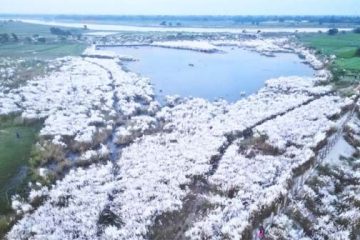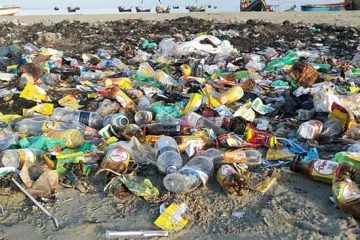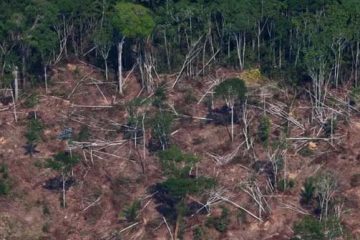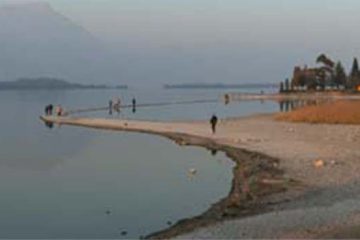Dr. Md. Mizanur Rahman
 LANTANA is a native evergreen shrub to tropical America. It is now a major weed in many regions of the Palaeotropics where it invades natural and agricultural ecosystems. The plants can grow individually in clumps or as dense thickets, crowding out more desirable species. It may grow up to 6 ft high and may spread to 8 ft as a climber with the help of a support. Leaves and stems are rough, hairy and secrete an unpleasant odour like cat pee when crushed. In the tropics lantana is a non-stop bloomer. Flower colour ranges from white to yellow, orange to red, pink to rose in unlimited combinations. In addition, the flower colour usually changes with the change of age.
LANTANA is a native evergreen shrub to tropical America. It is now a major weed in many regions of the Palaeotropics where it invades natural and agricultural ecosystems. The plants can grow individually in clumps or as dense thickets, crowding out more desirable species. It may grow up to 6 ft high and may spread to 8 ft as a climber with the help of a support. Leaves and stems are rough, hairy and secrete an unpleasant odour like cat pee when crushed. In the tropics lantana is a non-stop bloomer. Flower colour ranges from white to yellow, orange to red, pink to rose in unlimited combinations. In addition, the flower colour usually changes with the change of age.
Its prolific all-year flowering allows rapid dispersal, and the seeds are spread fairly long distances by birds. Lantana is very easy and fast growing species adapted to most soil types. It is also very drought and salt resistant and seldom bothered by pests or disease. It needs low water content to grow and can be used in xericapes. It is also happy with both humid and hot weather. In temperate regions lantana is used as hedge plant, which adds vibrant long-lasting colour to the garden. The gardeners in cold climates enjoy this tropical plant as an annual shrub for its fast growing and quick flowering characters.
It is invading and disrupting native plant communities in different parts of the world.
Invasion on forest biodiversity
Our natural forests are characterised by intensive land-use and high levels of habitat destruction or fragmentation resulting in sharply fragmented habitat mosaics. Plant communities are more susceptible to invasion by alien lantana. Invasion by lantana changes floristic composition in fragmented forests. Habitat modification and the introduction of invasive lantana cause local decline, and even extinction of native species (Pimm 1986). Sporadic tree felling and lopping of trees create localised patches or canopy gaps. The microclimatic conditions in fragmented forests are favourable for the establishment of opportunist and exotic lantana.
The canopy opening increases resource availability including windows and light regime for this invader. Lantana coverage decreases with the increasing of tree canopy closure. Lantana invasion changes community composition, diversity, and ecosystem functioning (D’Antonio & Vitousek 1992). Plant diversity and species richness show a decreasing trend in the deciduous forests of Bangladesh with the increasing of lantana cover. Dense shade of lantana reduces the intensity and duration of light, prevents the establishment of herbs and tree seedlings by creating horizontal stratification. Lantana suppresses natural regeneration of tree species through its competitive superiority over seedlings of native species.
As a result, homogeneous and mono-specific invaded understorey is forming in the forests. This invasive species cover creates demographic instability among tree species, and reduces tree diversity potentially by changing the structure of the forest. It becomes dominant understorey shrub by suppressing native shrubs in the Sal forests. The dense thickets transform degraded forest into shrubland. Its allelopathic qualities can affect the growth of nearby plants.
Invasion on agricultural biodiversity
Fodder crops, pulse crops, medicinal crops, cereals and ornamental plants are also highly susceptible to lantana invasion. Some crops become locally extinct with increasing levels of lantana cover. Lantana interferes agricultural harvesting and reduces the economic viability of certain crops. The soil has a lower capacity to absorb water in dense stands of lantana than in grass cover, increasing run-off and therefore soil erosion. Lantana leaf extracts causes inhibitory effect on germination, root and shoot elongation and development of lateral roots of major agricultural crops of Bangladesh (Ahmed et. al. 2007). It affects economic viability of tea, coconut and cotton (Holm et al. 1977). Lantana harbours several serious pests of agricultural crops.
Impacts on animals
Pet animals become ill after ingesting lantana. The dense thickets of lantana affect bird breeding by impeding flight. Its leaves and seeds contain triterpenoids, which cause poisoning of a number of animals including cattle, buffalo, sheep and goats (Sharma et al. 1988). Poisoning mainly occurs in newly introduced young animals without access to other fodder (Sharma 1994). Green fruits are poisonous to humans and can cause death. Malarial mosquitoes shelter in bushes and are the cause of serious health problem.
Management
Cultural
o Introducing desirable trees to shade out regeneration of lantana
o Gap filling by of rose trees pioneer and early successional species
o Aforestation and reforestation by native and natural species
o Facilitating natural regeneration in degraded forests
o Promoting natural succession in the degraded and denuded forests
o Stopping further clear felling and illegal logging
o Protecting natural regenerations (seedling, sapling and juvenile trees) from cutting
Mechanical
o Digging out lantana thickets
o Burning of the thickets
Chemical
o Foliar applications of 2,4-D, MCPA, dicamba, triclopyr, Glyphosate and picloram effective on plants less than 2m tall
o Basal application for larger plants
Biological
o The following insects can be used as bio-control agents: lace bug, lantana leafminer, lantana leaf beetle, lantana seed fly, leaf-chewing moth and lantana defoliator
o The pathogenic fungi Prospodium tuberculatum, Puccinia lantanae and Ceratobasidium lantanae-camarae can be considered for use as biological control agents
Dr. Md. Mizanur Rahman, a biodiversity specialist is Assistant Commissioner, Jhalakathi Collectorate, E-mail: mizan_peroj @yahoo.com





